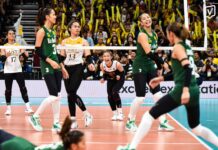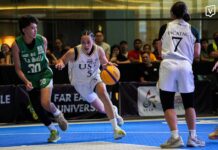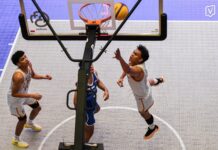UAAP competition has become tougher, but UST is still not keen on seeking more private benefactors to lure better athletes.
Fr. Ermito de Sagon, O.P., director of the Institute of Physical Education and Athletics (IPEA), insisted that the University would not spend big amounts of money for sports just because it’s a “well-known school,” saying the practice was unethical.
“We maintain that our athletes are amateurs. If they want to play in UST, we welcome them but those who think they need to get something out of their skill and are being offered [something] somewhere else, they may go,” he told the Varsitarian.
De Sagon said that it was not good to offer enormous allowances to athletes, arguing that those who joined a school only because of financial reward were also prone to “selling” games.
But some of UST coaches and athletes believe it is time to open the doors for wider sponsorships to keep in step with emerging universities, particularly the Hans Sy-backed National University.
For Tiger Jins coach Jasmine Simpao, UST teams should have a consistent and firm support system to maintain the competitiveness of the athletes.
“We need all the support that we can get, though the University is providing us all that we need, but nowadays it’s very competitive already. Like other universities who offer (more benefits), they get elite athletes,” he said.
Dylan Ababou, former Growling Tiger and UAAP Most Valuable Player, said the University should consider bigger sponsors, noting that not all the players were born in a well-to-do family.
Odjie Mamon, national men’s volleyball team and UST volleyball head coach, said he was more interested in alumni support than corporate sponsorship.
Growling Tigresses chief tactician Chris Cantonjos shared the same sentiment, saying alumni support could boost the players’ morale.
De Sagon said UST’s sports program and policies have remained despite losing the general championship to De La Salle University for two straight years. He said that IPEA respects UST’s value of education more than the athletics but finds the strict academic policies as a disadvantage, stressing that every college has to undergo accreditation so it does not want players or students with failures.
Different colleges and faculties of the University go through a yearly accreditation from the Commission on Higher Education and other organizations that check if the academic programs meet the standards of quality education and students with failures are considered a demerit.
“It is not about changing the program, sometimes we lose so many players because of graduation or ineligibility, incurring so many failures. Even if you have the good players, they cannot play because of deficiencies so your sports program is affected,” he added. But most of the coaches asserted that UST should invest money on the recruitment process given that it is the first step in beefing up the teams’ rosters.
UST has been the victim of countless “athlete piracy” in the past and has been the last option for many big names in terms of recruitment.
Growling Tigers head coach Bong de la Cruz stressed the need for a bigger budget in acquiring athletes as, he said, other universities usually get “Class A” players while UST settles for “Class C”, although there are few top players who choose to join the Tigers’ lair.
Some of the highly-touted athletes that suited for UST are former NCAA juniors basketball MVP Louie Vigil, UAAP juniors basketball best scorer Renzo Subido, UAAP girls’ volleyball MVP Ennajie Laure and the Cebu volleyball standouts Cherry Ann Rondina and Rica Jane Rivera.
“We need to fight in the recruitment because you want to get some of the best players because if we have good athletes then you just have to develop them for a short time,” told Dela Cruz.
Tiger Spiker Mark Gil Alfafara argued that offering financial benefits to athletes did not necessarily make them money-grubbers. There are just some players, especially those from the provinces, that came from poor families, he said.

















For me, tama si Mark Alfafara. Sorry if I’m rude about this pero never bang naisip ni Fr. de Sagon na karamihan sa magagaling na Athletes came from provinces na hindi gaanong kayang tustusan ang pangangailangan nila. Sure, giving athletic scholarship would greatly support their educational needs pero still hindi sapat yun. If you were to put in recruitment scenario at ikaw yung athlete, anong mas pipiliin mo? School A, bounded with great historical heritage (Also in UAAP) pero ang kaya lang ibigay sa’yo ay scholarship at kititing na allowance or School B, na hindi gaanong sikat at wala pang masyadong history sa UAAP pero kayang supportahan ang bawat athlete with financial aid (includes allowance, books, transportation, etc.). Ang buhay ngayon ay mas mahirap compared noong dekada sitenta-nobenta. Siyempre dun ka na sa practical na School.
FYI. I’m a PROUD Thomasian pero I had to say this. Sure, nagchachampion yung UST ngayon sa different sports (Women’s Beach Volleyball, Men’s Taekwondo, Women’s T&F, Men and Women’s Judo, etc…) pero in about 5-6 years from now I assure you, mahihirapan na magchampion ang UST even with General Championship kasi nagiging competitive na yung ibang schools. As far as I know, some UAAP schools are already linked with the corporate industry.
Magiging proud na lang ba tayo sa HISTORY lang? Just because “well-known” school ang ating pamantasan ganun na lang ba ‘yun? Of course, we have to prove in every season, in every year na tayo ang Kampion.
It’s a different era of UAAP and even in Academics. Napapag-iwanan na ang UST.